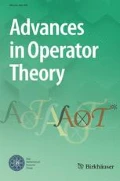Abstract
In this paper, we are concerned with the generalized wave equations in the homogeneous Triebel–Lizorkin spaces. The long time decay estimates are obtained by the decomposition of the unit, duality property and the multiplier theorems, extending the known results for the generalized wave equations with structure dissipation in the real Hardy spaces.
Similar content being viewed by others
References
Bui, H.-Q., Taibleson, M.: The characterization of the Triebel–Lizorkin spaces for \(p=\infty \). J. Fourier Anal. Appl. 6(5), 537–550 (2000)
Chen, J., Deng, Q., Ding, Y., Fan, D.: Estimates on fractional power dissipative equations in function spaces. Nonlinear Anal. 75, 2959–2974 (2012)
Cho, Y.-K.: Continuous characterization of the Triebel–Lizorkin spaces and Fourier multipliers. Bull. Korean Math. Soc. 47(4), 839–857 (2010)
D’Abbicco, M., Ebert, M.R., Picon, T.: Long time decay estimates in real Hardy spaces for evolution equations with structure dissipation. J. Pseudo Differ. Oper. Appl. 7, 261–293 (2016)
D’Abbicco, M., Ebert, M.R.: A classification of structural dissipations for evolution operators. Math. Methods Appl. Sci. 39, 2558–2582 (2016)
Frazier, M., Jawerth, B.: A discrete transform and decompositions of distribution spaces. J. Funct. Anal. 93(1), 34–170 (1990)
Ikehata, R.: Asymptotic profiles for wave equations with strong damping. J. Differ. Equ. 257, 2159–2177 (2014)
Ikehata, R., Todorova, G., Yordanov, B.: Wave equations with strong damping in Hilbert spaces. J. Differ. Equ. 254, 3352–3368 (2013)
Karch, G.: Selfsimilar profiles in large time asymptotics of solutions to damped wave equations. Stud. Math. 143, 175–197 (2000)
Matthes, S., Reissig, M.: Qualitative properties of structurally damped wave models. Eurasian Math. J 3, 84–106 (2013)
Miyachi, A.: On some Fourier multipliers of \(H^p\). J. Fac. Sci. Univ. Tokyo Sect. IA Math. 27, 157–179 (1980)
Peetre, J.: On spaces of Triebel–Lizorkin type. Ark. Mat. 13, 123–130 (1975)
Ponce, G.: Global existence of small solutions to a class of nonlinear evolution equations. Nonlinear Anal. 9, 399–418 (1985)
Shibata, Y.: On the rate of decay of solutions to linear viscoelastic equation. Math. Methods Appl. Sci. 23, 203–226 (2000)
Triebel, H.: Theory of Function Spaces. Monographs in Mathematics, vol. 78. Birkhauser, Basel (1983)
Acknowledgements
This research was supported by National Natural Science Foundation of China (Grant nos. 11671363, 11471288, 11601456).
Author information
Authors and Affiliations
Corresponding author
Additional information
Communicated by Mark Veraar.
Appendix
Appendix
Firstly, let us recall the characterization of \(H^{p}(\mathbb {R}^{n})\) using the Riesz transforms. Let \(R_{J},J=(j_{1},\ldots ,j_{s})\in \{0,1,\ldots ,n\}^{s},\) be the generalized Riesz transform of order s, i.e. the Fourier multiplier transformation \(T_{m}\) with
where the factor \((-i\xi _{j_{1}}/|\xi |)\) shall be replaced by 1 if \(j_i=0,\) where \( i\in \{0,1,\ldots ,n\}\) [11].
With this assumption, we have the following theorem.
Theorem 5
([11]) Let \(p > (n-1)/(n-1+s).\) Then \(f\in L^2(\mathbb {R} ^{n}) \bigcap H^p(\mathbb {R}^{n})\) if and only if \(R_Jf\in L^2(\mathbb {R} ^{n}) \bigcap L^p(\mathbb {R}^{n}) \) for all \(J\in \{0, 1, \ldots , n\}^s;\) and there exist constants C and \(C^{^{\prime }}\) depending only on p, n, and s such that
Next, we recall a multiplier theorem of \(H^{p}(\mathbb {R}^{n})\) in [11], where \(\mathcal {M}(H^{p}(\mathbb {R}^{n}))\) denotes the set of all Fourier multipliers on \(H^{p}(\mathbb {R}^{n}).\)
Theorem 6
([11]) Let \(c\ge 0, d\ge 0, 0< p_0 < 2, nd(1/p_0 - 1/2) = c,\) and \(k=\max \{[n(1/p_0 - 1/2)] + 1, [n/2] + 1\}.\) Suppose that \(m \in C^k(\mathbb {R}^n\setminus \{0\}), m(\xi )=0\) if \(|\xi | \ge 1,\) and
with some constant \(A \ge 1.\) Then \(m \in \mathcal {M}(H^p(\mathbb {R}^n))\) and
for \(2 \ge p \ge p_0,\) where C is a constant independent of A.
Rights and permissions
About this article
Cite this article
Chen, J., Fan, D. Triebel–Lizorkin space estimates for evolution equations with structure dissipation. Adv. Oper. Theory 5, 281–300 (2020). https://doi.org/10.1007/s43036-019-00019-8
Received:
Accepted:
Published:
Issue Date:
DOI: https://doi.org/10.1007/s43036-019-00019-8


